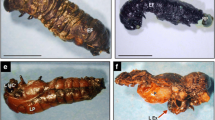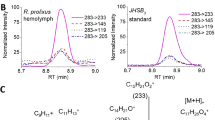Abstract
The effect of five juvenile hormone analogues (JHAs) on the embryonic development of Panstrongylus megistus, a vector of Chagas’ disease, was studied. Four compounds, N-(2,5-dich-loropheny])-3,7-dimethyl-2-6-octadienylamine, N-(5-chloro-2-rnethylphenyl)-3,7-dimethyl-2,6-octadienylamine, 3,7-dimethyl-6,7-epoxy-1-(3,4-methylenedioxyphenoxy)-2-nonene, and 6,7-epoxy-3-ethyl-7-methyl-1-(3,4-methylenedioxyphenoxy)-2-nonene, which are potent JHAs for P. megistus, were effective in blocking eclosion when applied at 0.5 µg/egg to eggs during the first half of embryonic development. If these compounds were applied after the start of blastokinesis, then they were no longer active as ovicides. The possibility is raised that JHAs may be useful as control agents in complementation with insecticides which do not possess ovicidal activity.
Similar content being viewed by others
References
Abbott W. S. (1925) A method for computing the effectiveness of an insecticide. J. econ. Ent. 18, 265–267.
Bustamante F. M. and Gusmão J. B. (1954) Sobre a possibilidade de erradicaçaõ do Triatoma infestans com duas ou três aplicações domiciliárias de BHC. Resultado de uma prova de campo. Revta bras. Malar. Doenç. trop. 6, 102–113.
Castro Filho J. and Silveira A. C. (1979) Distribuição da doença de Chagas no Brasil. Revta bras. Malar. Doenç. trop. 31, 85–98.
Dias E. (1975) Profilaxia de Doença de Chagas. O Hospital 51, 285–298.
Dias E. and Pellegrino J. (1948) Alguns ensaios com o Gammexane no combate aos transmissores da doença de Chagas. Bras. med. 62, 185–191.
Dias E., Silva Pinto O., Pellegrino J. and Castro J. A. (1952) Ensaio experimental de luta contra os Triatomíneos por meio de inseticidas de ação residual. Revta bras. Malar. Doenç. trop. 4, 22–46.
Enslee E. C. and Riddiford L. M. (1970) Morphological effects of juvenile hormone analogues on embryos of Pyrrhocoris apterus. Am. Zool 10, 527.
Martínez. A., Cichero J. A., Alania I. R. and González F. (1975) Control of Triatoma infestans (Klug) with malai]athion concentrate. J. med. Ent. 11, 653–657.
Martínez-Pardo R., Ribo J. and Primo-Yufera E. (1979) Activity of juvenile hormone mimics against the mediterranean fruit fly. J. econ. Ent. 72, 437–440.
Novák, V. J. A. (1969) Morphogenetic analysis of the effects of juvenile hormone analogues and other morphogenetically active substances on embryos of Schistocerca gregaria (Forskal). J. Embryol. exp. Morph. 21, 1–21.
Oliveira Filho A. M., Pinchin R., Figueiredo M. J., Muller C. A., Conçalves J. R. S. and Gilbert B. (1981) Structure activity relationships of 110 candidate juvenile hormone analogues for Panstrongylus megistus (Burmeister 1835), a vector of Chagas’ disease. (Hemiptera, Reduviidae, Triatominae). Revta bras. Biol. 41, 197–204.
Patterson J. W. and Schwarz M. (1977) Chemical structure, juvenile hormone activity and persistence within the insect of juvenile hormone mimics for Rhodnius prolixus. J. Insect Physiol. 23, 121–129.
Patterson J. W. and Schwarz M. (1979) The activity of juvenile hormone mimics for the eggs of Rhodnius prolixus. J. Insect Physiol. 25, 399–404.
Penalver L. M. and Villagran E. L. (1955) Experimentos con el insecticida dieldrin en la lucha antitriatomidea. Bol of. San. Panam. 38, 127–141.
Picollo M. I., Wood E. J., Licastro S. A. and Zerba E. N. (1976) Actión ovicida de insecticidas organofosforados en Triatoma infestans (Vinchuca). Acta Bioquim. Clin. Lalinoamer. 10, 309–320.
Pinchin R., Oliveira Filho A. M., Figueiredo M. J., Muller C. A., Gilbert B., Szumlewicz A. P. and Benson W. W. (1978) Screening and structure-activity relationships of synthetic juvenile hormone analogues for Panstrongylus megistus, a primary vector of Chagas’ disease in Brazil. J. econ. Ent. 71, 950–955.
Retnakaran A. (1970) Blocking of embryonic development in the spruce budworm, Choristoneura fumiferana (Lepi-doptera, tortricidae), by some compounds with juvenile hormone activity. Can. Ent. 102, 1592–1596.
Riddiford L. M. (1972) Juvenile hormone and insect embryonic development: its potential role as an ovicide. In Insect Juvenile Hormones: Chemistry and Action (Edited by Menn J. J. and Beroza M.), pp. 95–112. Academic Press, New York.
Riddiford L. M. and Williams C. M. (1967) The effects of juvenile hormone analogues on the embryonic development of silkworms. Proc. natn. Acad. Sci. 57, 595–601.
Sherlock I. A., Muniz T. M. and Guitton N. (1976) A Ação do malathion sobre os ovos de Triatomíneos vetores da doença de Chagas. Rev. Soc. Bras. Med. Trop. 10, 77–84.
Slama K. and Williams C. M. (1966) Paper factor as an inhibitor of the embryonic development of the european bug, Pyrrhocoris apterus. Nature Lond. 210, 329–330.
Szumlewicz A. P. (1954) A eficácia do expurgo domiciliário com hexaclorociclohexana no controle dos vetores da doenca de Chaças (a importância de alguns característicos biológicos dos Triatomineos no planejamento do ciclo de aplicação do inseticida). Revta bras. Malar. Doenç. trop. 6, 63–100.
Villar M. I. P. (1979) Caracterización del dessarollo embrionario de Triatoma infestans (Vinchuca) y su relación con la susceptibilidad a insecticidas organofosforados. Ph.D. Thesis, Universidad de Buenos Aires, 99 pp.
Walker W. F. and Bowers W. S. (1970) Synthetic juvenile hormone as potential coleopteran ovicides. J. econ. Ent. 63, 1231–1233.
Wall C. (1974) Disruption of embryonic development by juvenile hormone and its mimics in Dysdercus fasciatus Sign. (Hemiptera, Pyrrhocoridae). Bull. ent. Res. 64, 421–433.
Williams C. M. and Kafatos F. C. (1972) Theoretical aspects of the action of juvenile hormone. In Insect Juvenile Hormones: Chemistry and Action (Edited by Menn J. J. and Beroza M.), pp. 29–41. Academic Press, New York.
Author information
Authors and Affiliations
Rights and permissions
About this article
Cite this article
Oliveira Filho, A.M., Pinchin, R., Figueiredo, M.J. et al. Blockage of Embryonic Development in Panstrongylus Megistus by Juvenile Hormone Analogues. Int J Trop Insect Sci 5, 127–130 (1984). https://doi.org/10.1017/S1742758400001788
Received:
Revised:
Published:
Issue Date:
DOI: https://doi.org/10.1017/S1742758400001788




